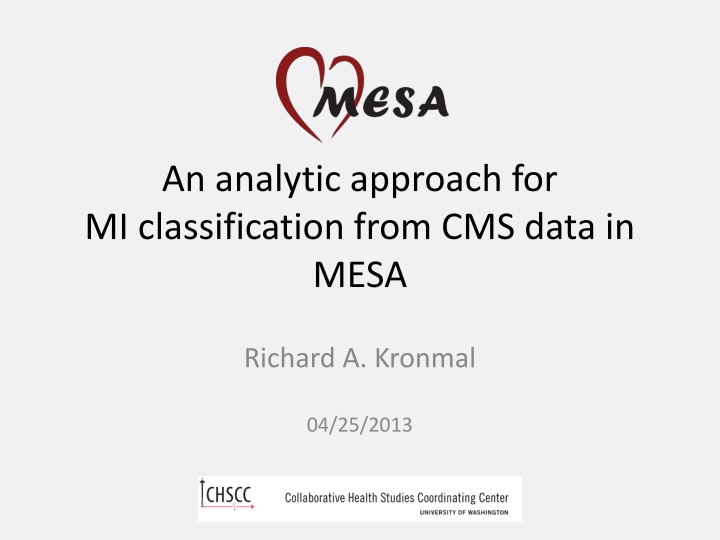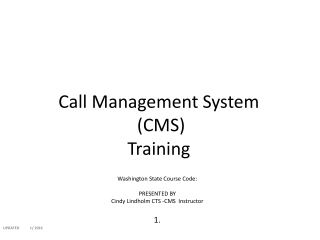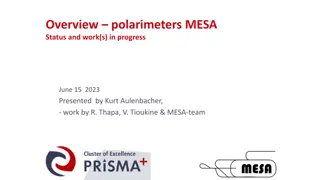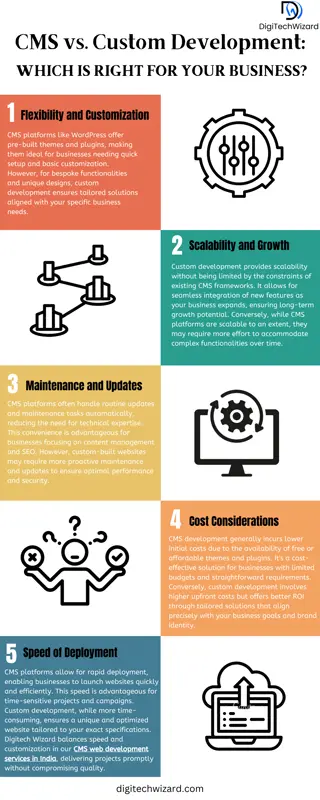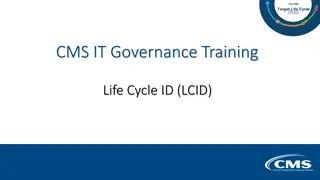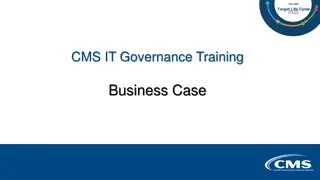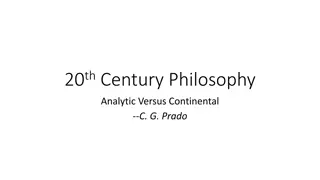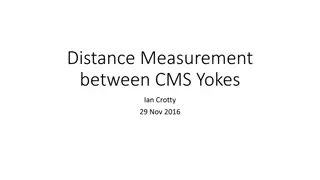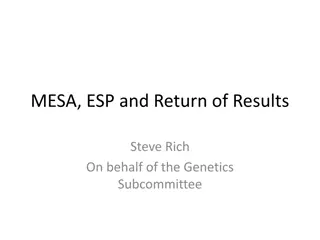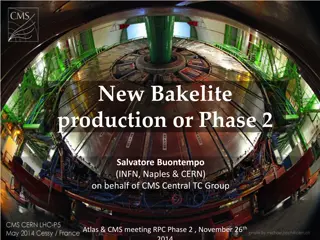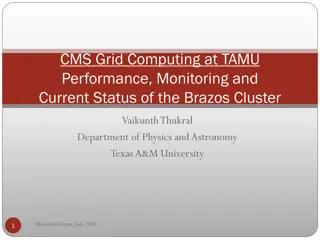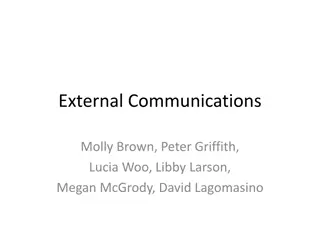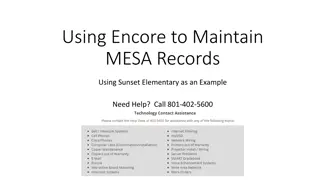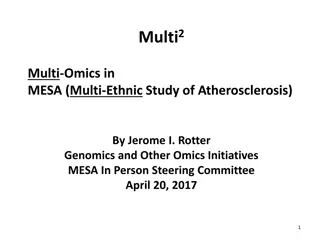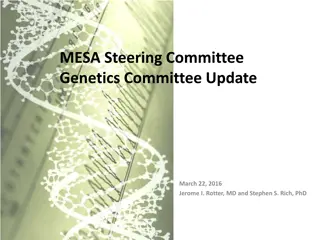Analytic Approach for MI Classification from CMS Data in MESA
This study focuses on applying an analytical approach to classify myocardial infarction (MI) using data from the Cardiovascular Health Study (CMS) in the Multi-Ethnic Study of Atherosclerosis (MESA). The research aims to develop effective methods for identifying and distinguishing MI cases within the dataset, contributing to advancements in cardiac health analytics and patient care strategies. By leveraging data-driven insights and sophisticated classification techniques, the project seeks to enhance the understanding and detection of MI patterns, thereby fostering better diagnostic accuracy and treatment outcomes in clinical settings.
Download Presentation

Please find below an Image/Link to download the presentation.
The content on the website is provided AS IS for your information and personal use only. It may not be sold, licensed, or shared on other websites without obtaining consent from the author.If you encounter any issues during the download, it is possible that the publisher has removed the file from their server.
You are allowed to download the files provided on this website for personal or commercial use, subject to the condition that they are used lawfully. All files are the property of their respective owners.
The content on the website is provided AS IS for your information and personal use only. It may not be sold, licensed, or shared on other websites without obtaining consent from the author.
E N D
Presentation Transcript
An analytic approach for MI classification from CMS data in MESA Richard A. Kronmal 04/25/2013
Important Considerations I. II. Benefit of adding CMS events. A. Improvement of precision. Likely to be small. B. Diminish bias. Can be quite important. C. Improve follow-up time for participants who are lost to follow-up. III. If many of the added CMS events are not true events A. Bias toward the null will be added which might nullify any bias reduction from adding the events. B. Similarly, there may be a loss of precision. How many additional events?
Define a CMS Participant I. Determine which MESA participants are eligible for CMS membership and those that actually use CMS for their medical care. A. Definition of eligible is a participant whose age is 65 prior to January 1, 2010 (CMS file includes claims from 2000 to the end of 2009). B. A user of CMS is defined to be a participant with at least one CMS claim for medical services. C. Table 1 shows the number of participants that fall into the categories defined by A & B above.
CMS Participants Table 1. Summary of MESA and CMS participants # of MESA participants eligible for CMS prior to last day of 2009 # of participants with CMS MI s prior to entry into MESA 4491 -43 # with no MESA follow-up -17 Total eligible MESA participants 4431 # with at least one CMS claim 3016
Participants in CMS among eligible MESA participants by Site Table 2. CMS Membership by Site Not in CMS In CMS Wake Forest 276 (38.0%) 451 (62.0%) Colombia 209 (30.6%) 475 (69.4%) Johns Hopkins 193 (25.6%) 561 (74.4%) Minnesota 197 (31.5%) 428 (68.5%) Northwestern UCLA 151 (19.8%) 389 (44.2%) 610 (80.2%) 491 (55.8%) Total 1415 (31.9%) 3016 (68.1%)
CMS Participants MI Status Table 3. Breakdown of MI status by CMS Claims or MESA Events Ascertainment among CMS Participants (at least one claim) MESA MI event prior to last day of 2009 111 Prevalent MI per CMS (Parts A or B) =5 -5 MI events from MESA 106 MI MESA only 34 CMS MI claims & MESA MI Event 72 CMS MI claims, no MESA MI event CMS MI claims (Part A Inpatient) CMS MI claims (Part B Carrier Inpatient Place of Service only) 65 27 38
Construction of Classification Rule for MI s ascertained from CMS Claims I. How do we determine a rule for classifying a CMS claim for an MI as a true MI? Find MESA hospitalizations with dates close in time to CMS inpatient (hospital or carrier) claims for MI. A. Determine count of separate inpatient and carrier hospital claims for above participants . B. Assume that MESA adjudicated MI is always correct, e.g. is the gold standard. C. Tabulate CMS count of MI hospital claims versus MESA MI classification. Two tables are done. a. Table 3 shows the count of MI inpatient hospital claims versus the MESA MI classification. b. Table 4 shows the count of carrier inpatient claims (no hospital inpatient claims) versus the MESA MI classification. Define a rule based on the data in Tables 4 & 5. II. III.
Construction of Classification Rule for MIs ascertained from CMS Claims Table 4. Count of hospital inpatient CMS MI claims versus MESA ascertained MI s when MESA hospital records exist for the date ( 30 days) of the CMS MI claim MESA MI Total # of CMS Hospital MI Claims No Yes 1 6 (12%) 44 (88%) 50 >1 0 (0%) 6 (9.4%) 58 (90.6%) 14 (100%) 14 64 Total
Description of 6 participants with CMS MI, but no MESA MI 1. Unstable angina, CABG 2. Mild elevation of cardiac enzymes, acute non-st MI 3. Unstable angina, CABG 4. Unstable angina, CABG 5. Possible MI, ruled out on basis of catherization 6. Chest Pain, jump in troponin from .2 to 4.9, three vessel disease, CABG
Construction of Classification Rule for MIs ascertained from CMS Claims Table 5. Count of carrier only (no hospital claims) CMS MI claims versus MESA ascertained MI s when MESA hospital records exist for the date ( 30 days) of the CMS MI claim. MESA MI Total # of CMS Carrier only Hospital MI Claims No Yes 1 17 (85%) 3 (23%) 3 (15%) 10 (77%) 20 13 >1 Total 20 (60.6%) 13 (39.4%) 33
Classification Rule for CMS MIs that are not MESA MI s 1. Rule to be applied to CMS MI participants for whom there are no MESA hospitalizations that correspond to the CMS MI date and no MESA MI. 2. If there are CMS hospital inpatient claims use one of the two strategies below: a. Classify all CMS MI s as true MI s. b. A strategy that would increase the classification accuracy would be to use weights for each CMS MI in proportion to the estimated probability from Table 4. 1) If the number of claims is 1, use a weight of 0.88. 2) If the number of claims is >1, use a weight of 1.00.
Classification Rule for CMS MIs that are not MESA MI s 3. Rule for carrier only claims two possible rules. a. Don t count any MI s that only have carrier claims. b. Count MI s when the number of carrier claims are 2 or more. This could be done with or without weighting. If weighting is used, for these MI s the weight would be 0.77.
Applying the Classification Rule 1. Hospital inpatient MI claims a. Count all MI s = 17 MI s with 1 claim, 5 with 2 =22 added MI s. b. Use weighting 0.88 x 17 + 1.00 x 5 = 19.96 added MI s 2. For carrier only MI claims a. Using first rule - Count 0 of the 17 carrier MI s b. 5 of the 17 MI s had >1 claim. Either count all MI s with >1 claim = 5 added MI s or use weighting -- 0.77*5=3.85 added MI s
Impact of adding CMS MI events All CMS hospital events and carrier events with counts of >1 (no weighting) Table 6. Site By MESA + CMS MI s for MESA CMS Eligible MESA MI only MESA MI + CMS MI Wake Forest 29 (4.0%) 29 (4.0%) Colombia 20 (2.9%) 22 (3.2%) Johns Hopkins 14 (1.9%) 20 (2.7%) Minnesota 29 (4.6%) 29 (4.6%) Northwestern UCLA 18 (2.4%) 27 (3.1%) 27 (3.6%) 37 (4.2%) Total 137 (3.1%) 164 (3.7%) Site Differences MESA MI s only p-value=0.032 Site Differences MESA + CMS MI s p-value=0.39
Discussion Adding the CMS MI s according to the rule proposed increases the number of MI s by about 20% with an acceptable level of misclassification. Future follow-up might decrease the number of events added due to our ascertainment of events missed in earlier follow-up. In the future we may not gain proportionally as many events as the results presented here are for about 9 years of follow-up. However, in the future more of our participants will be using CMS and more will be lost to follow-up, thus potentially increasing the importance of the CMS event ascertainment.
Discussion The classification rule is based on a small sample of events and therefor is subject to sampling error and thus imprecise estimates of the misclassification rates. The rule suggested needs to be tested on a new sample from another study. While using a weighting adjustment for the new events would provide an unbiased classification rule, it has the disadvantage of complexity in the analyses using the new events and would be more difficult to explain to users of the events and journal reviewers. The gain from using the weights would likely be small.
Discussion If we can get CMS and IRB permission to obtain the hospital records for the CMS MI events not found in the MESA follow-up, this would result in more accurate determination of the true events and is thus desirable. Other events may require different rules than the one suggested for MI. This is particularly true for events that frequently occur in the outpatient setting (CHF) or for which we have no gold standard for the event (atrial fibrillation).
Discussion Use of CMS follow-up will result in increased follow-up time for some of our participants. In order for our follow-up to be consistent for participants who are using or not using CMS, we recommend that our follow-up event files be done on a calendar year basis rather than on a follow-up phone call schedule.
Next Steps We will be investigating the classification of the other major CVD events from the CMS data in the coming months. This is a long and complex activity and requires careful checking so it will be a while before we can incorporate the new CMS events into the MESA event files. We will validate and improve the rule using data from CHS. We expect to receive soon the CMS files for 2010 and 2011 and will incorporate these into our CMS events files.
